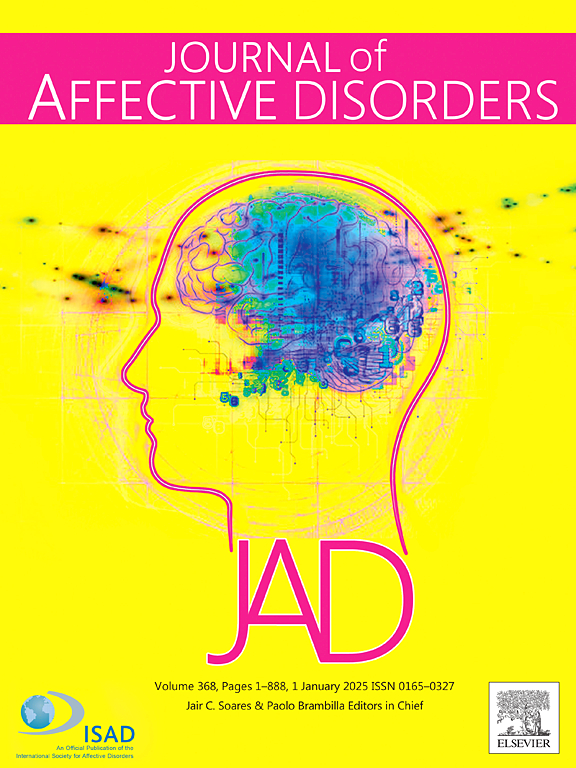Mitochondrial respiration in patients with bipolar disorder: Can mitochondrial respiratory control ratios serve as state and/or trait markers?
IF 4.9
2区 医学
Q1 CLINICAL NEUROLOGY
引用次数: 0
Abstract
Background
Bipolar disorder (BD) is a multifactorial disorder whose pathophysiology is not fully understood. Mitochondrial dysfunction has been proposed as a part of the molecular background of BD. Mitochondrial dysfunction, manifested as changes in oxygen consumption, can be detected in peripheral blood and may serve as potential state or trait marker of BD.
Methods
Mitochondrial respiration was analyzed in blood platelets obtained from BD patients in manic/depressive episode and in remission and compared with controls. 52 BD patients and 66 healthy age-matched controls were recruited. BD was clinically assessed using diagnostic scales and questionnaires. High-resolution respirometry was used to determine mitochondrial respiratory control ratios in both intact and permeabilized platelets.
Results
In BD patients in remission, the capacity of complex II-linked respiration and reserve respiration were decreased compared to controls in intact platelets. In permeabilized platelets, physiological respiration, electron transfer system (ETS) capacity, and excess capacity were decreased in BD patients compared to controls. When comparing acute states and remissions, more pronounced changes in respiratory parameters were observed in intact platelets after treatment of depression than after treatment of mania. In permeabilized platelets, qualitative changes in respiratory parameters did not depend on the type of episode prior to pharmacotherapy.
Conclusions
Mitochondrial dysfunction is implicated in BD pathophysiology and is associated with alterations in both activity of respiratory complexes and availability of substrates for oxidative phosphorylation. In intact platelets, complex II-linked respiration/ETS capacity could be potential blood-based trait biomarker for BD. Complex I-linked respiration/ETS capacity in permeabilized platelets could serve as state marker.
双相情感障碍患者的线粒体呼吸:线粒体呼吸控制比率能否作为状态和/或特征标记?
背景:双相情感障碍(BD)是一种病理生理尚不完全清楚的多因素障碍。线粒体功能障碍被认为是BD的分子背景的一部分。线粒体功能障碍表现为耗氧量的改变,可以在外周血中检测到,可能是BD的潜在状态或特征标志物。方法:分析躁郁症/抑郁发作和缓解期BD患者的血小板中线粒体呼吸的变化,并与对照组进行比较。招募了52名BD患者和66名年龄匹配的健康对照组。采用诊断量表和问卷对BD进行临床评估。采用高分辨率呼吸计测定完整血小板和通透血小板的线粒体呼吸控制比率。结果:在缓解期的BD患者中,与对照组相比,复合ii联呼吸和储备呼吸的能力降低。在渗透性血小板中,与对照组相比,BD患者的生理呼吸、电子传递系统(ETS)容量和过剩容量降低。当比较急性状态和缓解时,在完整的血小板中观察到抑郁症治疗后呼吸参数的变化比躁狂症治疗后更明显。在通透性血小板中,呼吸参数的质变不依赖于药物治疗前发作的类型。结论:线粒体功能障碍与BD病理生理有关,并与呼吸复合物活性和氧化磷酸化底物可用性的改变有关。在完整的血小板中,复合i -联呼吸/ETS能力可能是BD潜在的基于血液的特征生物标志物。渗透血小板中复合i -联呼吸/ETS能力可以作为状态标志物。
本文章由计算机程序翻译,如有差异,请以英文原文为准。
求助全文
约1分钟内获得全文
求助全文
来源期刊

Journal of affective disorders
医学-精神病学
CiteScore
10.90
自引率
6.10%
发文量
1319
审稿时长
9.3 weeks
期刊介绍:
The Journal of Affective Disorders publishes papers concerned with affective disorders in the widest sense: depression, mania, mood spectrum, emotions and personality, anxiety and stress. It is interdisciplinary and aims to bring together different approaches for a diverse readership. Top quality papers will be accepted dealing with any aspect of affective disorders, including neuroimaging, cognitive neurosciences, genetics, molecular biology, experimental and clinical neurosciences, pharmacology, neuroimmunoendocrinology, intervention and treatment trials.
 求助内容:
求助内容: 应助结果提醒方式:
应助结果提醒方式:


